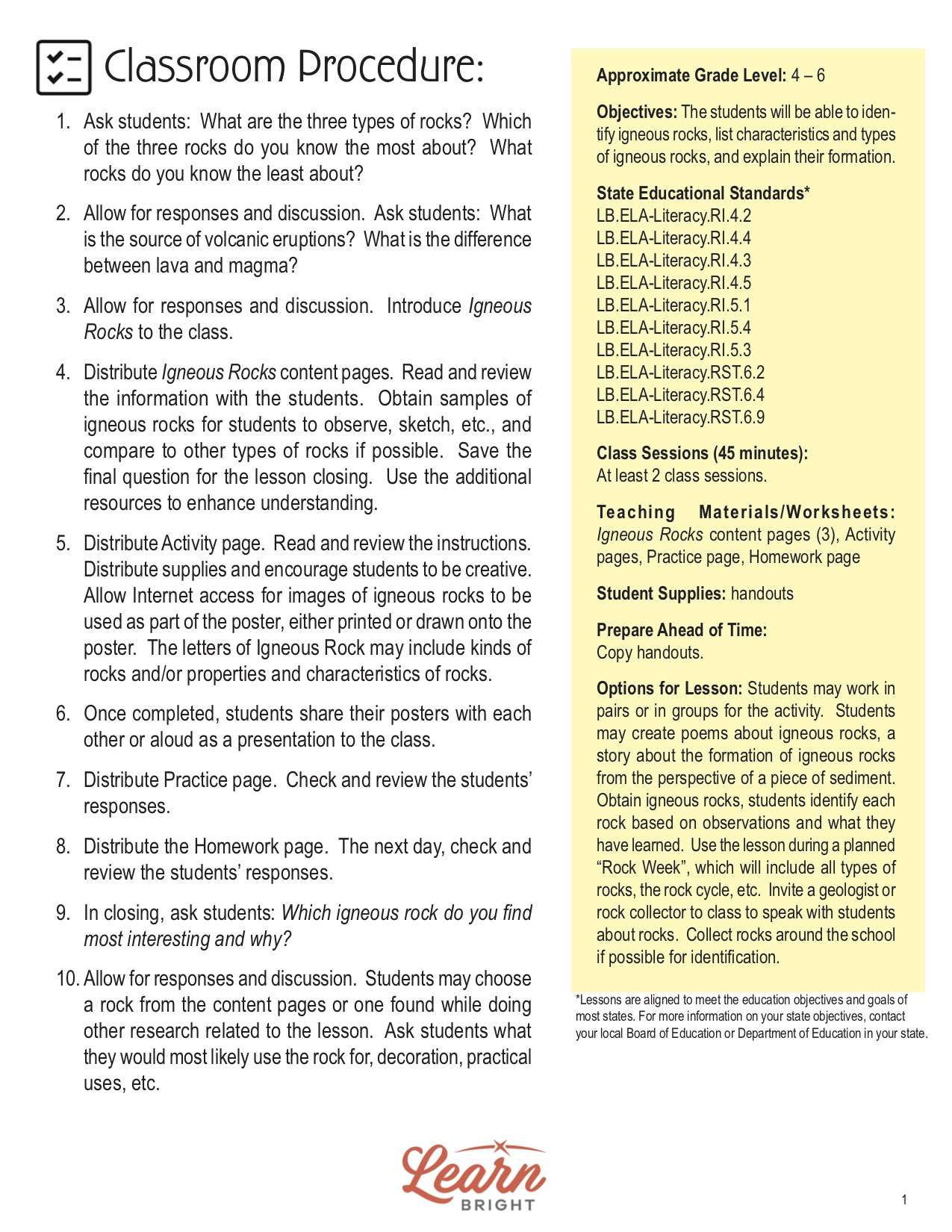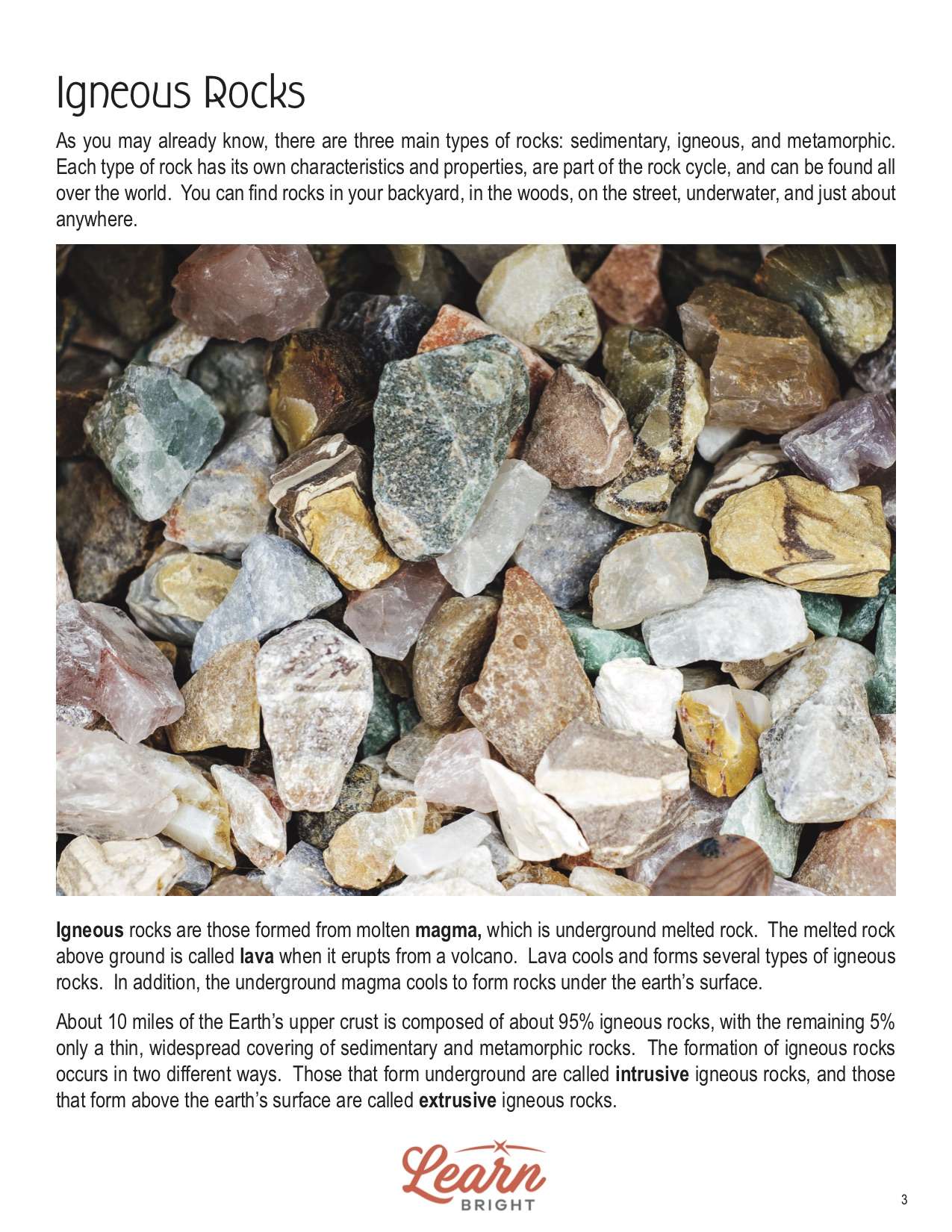Description
What our Igneous Rocks lesson plan includes
Lesson Objectives and Overview: Igneous Rocks teaches students the traits and properties of this group of rocks. Students will discover many of the different rock types that fall into the igneous category. They will be able to identify types of rocks based on their traits and properties. They will also be able to explain how igneous rocks form during the rock cycle. This lesson is for students in 4th grade, 5th grade, and 6th grade.
Classroom Procedure
Every lesson plan provides you with a classroom procedure page that outlines a step-by-step guide to follow. You do not have to follow the guide exactly. The guide helps you organize the lesson and details when to hand out worksheets. It also lists information in the yellow box that you might find useful. You will find the lesson objectives, state standards, and number of class sessions the lesson should take to complete in this area. In addition, it describes the supplies you will need as well as what and how you need to prepare beforehand.
Options for Lesson
The “Options for Lesson” section of the classroom procedure page lists a number of ideas for activities to add to the lesson. One optional addition is for students to create poems or stories about the formation of an igneous rock from the perspective of a piece of sediment. Another idea is to obtain different rocks and have students identify each one based on what they observe and what they learned. You could also plan a “Rock Week” during which you teach about all the types of rocks, including this lesson and the one on the rock cycle. One final option is to invite a geologist or rock collector to speak with the class and answer their questions.
Teacher Notes
The paragraph on the teacher notes page describes a little more about what to expect from this lesson. It suggests teaching this lesson at the same time as others on the other types or rocks or related lessons. You can use the blank lines on this page to write down any ideas you have as you prepare to present the lesson to your students.
IGNEOUS ROCKS LESSON PLAN CONTENT PAGES
Introduction to Igneous Rocks
The Igneous Rocks lesson plan contains five pages of content. The first page reminds students what the three main types of rocks are and that they all have different traits and properties. The lesson then explains where the igneous class of rocks come from and how they form. These rocks form from molten magma. When the magma cools underground, it forms intrusive igneous rocks. After magma erupts from a volcano as lava and then cools, it forms extrusive igneous rocks.
Extrusive and Intrusive
Extrusive rocks form very quickly and have a somewhat glassy texture. They form on the surface of the Earth and often only take a few hours to cool. We also call them volcanic rocks because they form from cooled lava. The atoms and molecules in magma rearrange themselves into mineral grains. As the magma cools down, the grains grow together and harden. Pumice and basalt are two examples of this type of rock.
On the other hand, intrusive rocks take much longer to form, and the crystals tend to be much larger. They form under the surface of the Earth, and those deep within the Earth’s crust can take thousands of years to cool down. These rocks have a grainy feel. Examples include granite and gabbro. Sometimes huge bodies of intrusive rocks form on the side of mountains. These are called batholiths, which can be as large as 60 miles across.
The lesson describes the three main types of volcanoes: shield, stratovolcanoes, and cinder cones. Each volcano forms different kinds of igneous rocks. A shield volcano spews lava that formed at a very high temperature and contained smaller amounts of silicon. This lava flows smoothly, cools, and forms basalt.
The lava from a stratovolcano is thicker and cooler than that of a shield. It also contains a lot more silica (mineral quartz). One rock that this lava forms is rhyolite, which is very close to granite except that it has much larger crystals. Cinder cones are big mountains of ash and rocks that form from splattering lava. Pumice is a common rock that results from these volcanoes. Rhyolite can form as well.
Types of Rocks
There are over 700 identified types of igneous rocks. The lesson describes several specific types of igneous rocks in a chart. Some of the most common intrusive rocks include diorite, gabbro, granite, pegmatite, and peridotite. The most common extrusive include basalt, obsidian, pumice, and rhyolite. A chart outlines some traits for each one and details what people use these rocks for.
Granite is a very popular type that students may already be familiar with. It is light-colored and is composed mainly of quartz and feldspar with small amounts of mica and other minerals. The mineral makeup gives it a red, pink, gray, or white color with dark mineral grains that are large enough to be easily visible. People use granite to make countertops, floor tiles, monuments, and other things.
Diorite is another intrusive rock that actually includes both granite and basalt. This rock crystallizes slowly within the Earth and has a salt and pepper look. Miners mine diorite to use as crushed stone and as the base for the construction of things like buildings and parking areas. It also helps with erosion control.
On the extrusive list is pumice, which is a very porous stone that forms during explosive volcanic eruptions. The pore spaces result from gas bubbles that were trapped in the rock during rapid cooling. Even though it’s a rock, it will actually float on water. Its most common use is as lightweight concrete blocks. People also use it as an abrasive, absorbent, or filler.
One more very interesting extrusive rock is obsidian. Usually black in color, this stone forms when molten rock cools so quickly that atoms are unable to arrange themselves as a crystalline structure. As a result, obsidian looks almost like glass. It can be brown, tan, or green, and in rare cases, it can even be blue, red, or orange. Its first use was as a cutting tool, like a knife, arrowhead, or spear point. Today, it is a popular gemstone.
Key Terms
Here is a list of the vocabulary words students will learn in this lesson plan:
- Magma—underground melted rock; liquid rock beneath a volcano
- Lava—the molten rock above ground after a volcano erupts
- Intrusive—a type of igneous rock that forms underground
- Extrusive—a type of igneous rock that forms above ground
- Batholith—a huge body of intrusive rocks that form inside mountains
- Shield volcano—a volcano that spews lava that formed at a very high temperature and that contains low amounts of silicon
- Silicon—a main ingredient in the mineral quartz
- Stratovolcano—a volcano with thicker and cooler lava that contains much more silica
- Cinder cone—a volcano that resemble a big mountain of ash and rocks formed by splattering lava
IGNEOUS ROCKS LESSON PLAN WORKSHEETS
The Igneous Rocks lesson plan includes three worksheets: an activity worksheet, a practice worksheet, and a homework assignment. Each one of these handouts will help reinforce students’ grasp of the lesson material and demonstrate what they learned in different ways. Refer to the guide on the classroom procedure page to determine when you should give your students the worksheets throughout the lesson.
ACROSTIC POEM ACTIVITY
For the activity worksheet, students will create an acrostic poem using the letters in “igneous rocks.” They must write either words or sentences that start with each letter. Whatever they choose needs to relate to the igneous category of rocks. After they create a rough draft on the worksheet, they can write their final draft on poster board. They should also include images, either that they draw or find from other sources.
MATCH THE ROCKS PRACTICE WORKSHEET
The practice worksheet will test students’ understanding of the traits of specific rock types. There are a total of 20 statements. Students will match the terms in the word bank to the statements. There are only nine types of rock in the word bank, so the words will be used more than once.
IGNEOUS ROCKS HOMEWORK ASSIGNMENT
There are two sections of the homework assignment. For the first part, students must match definitions to the correct terms. There are 10 terms and definitions. For the second part, they will answer a series of 10 questions based on their knowledge of the lesson material.
Worksheet Answer Keys
The last couple pages of the lesson plan document are answer keys for both the practice worksheet and the homework assignment. The correct answers are all in red so that it is easy for you to compare them with students’ responses. If you choose to administer the lesson pages to your students via PDF, you will need to save a new file that omits these pages. Otherwise, you can simply print out the applicable pages and keep these as reference for yourself when grading assignments.









